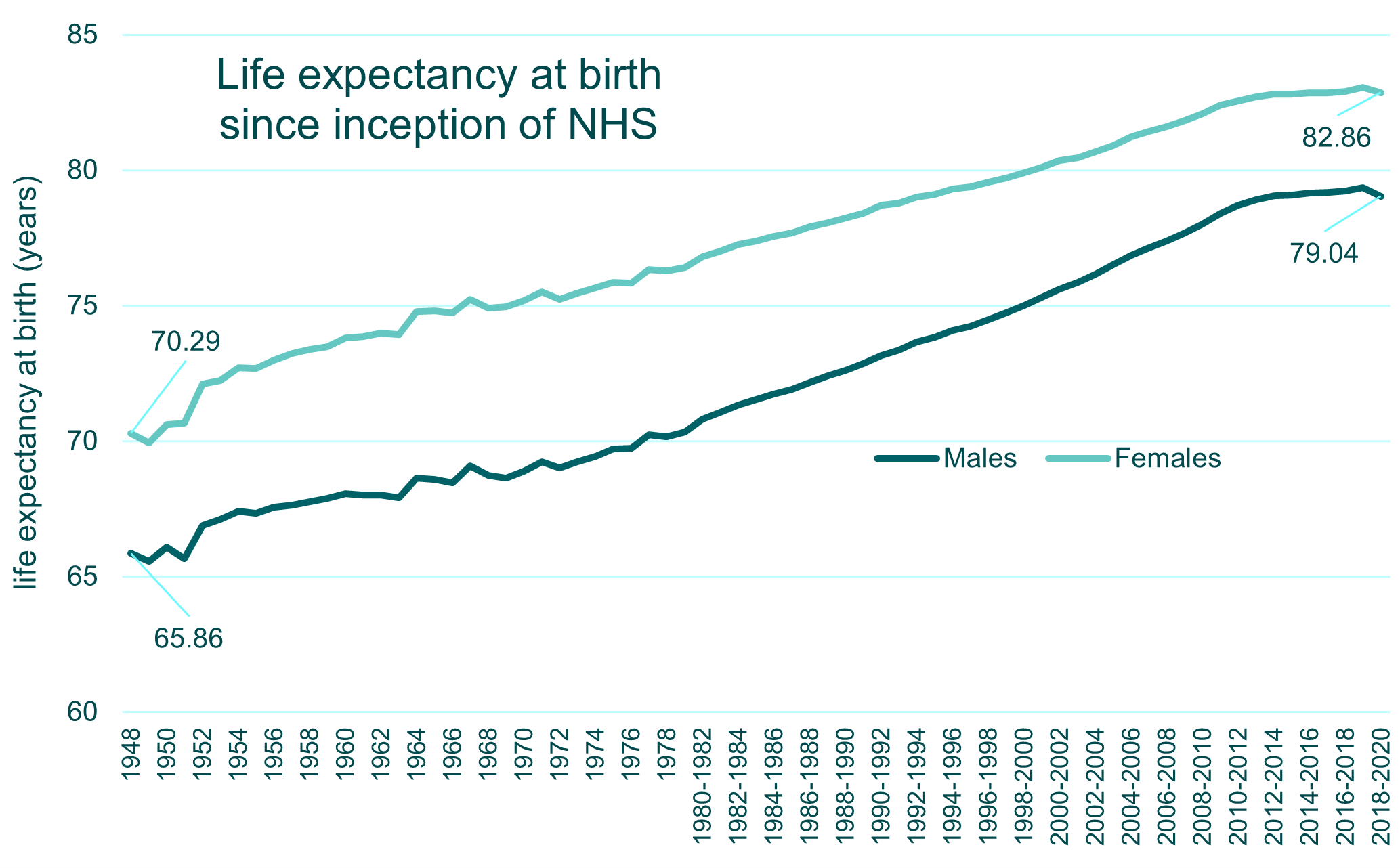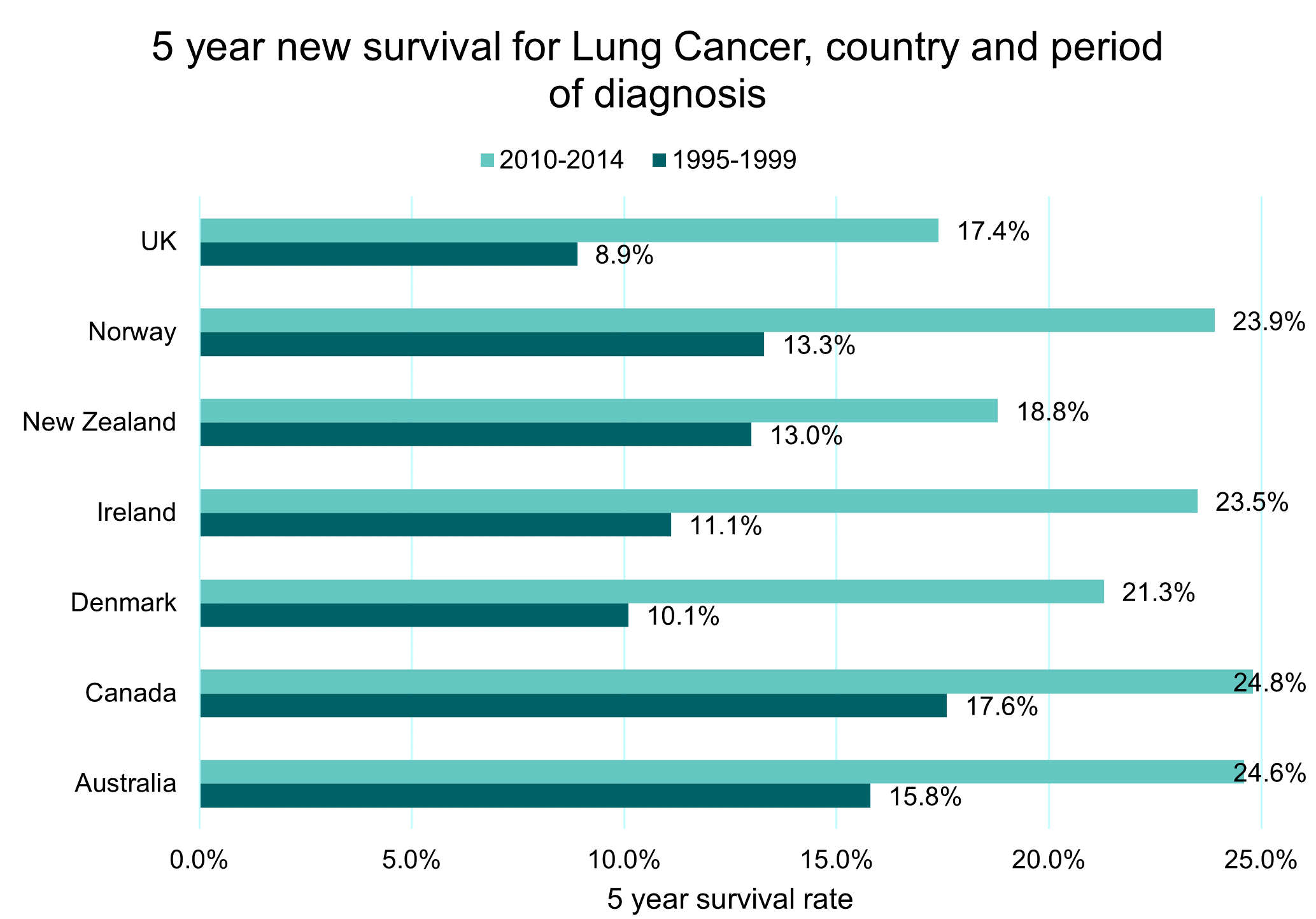Sign up to our newsletter Subscribe
Analysing Global Immunisation Expenditure

Sign up to our newsletter Subscribe


We have delved into the OHE archives to reflect on past NHS successes. In part one of a two-part Insight series, we look at three major contributors to shorter life expectancies – tuberculosis, heart disease, and cancer.

Source: ONS
Life expectancy has risen consistently
The health of the UK population has continuously improved over the last seventy-five years. In 1948, life expectancy was just about “three-score years and ten”, with men born in that year expecting to live until 66 and women 70. By 2020, this had increased to 79 years and 83 respectively. It is too early to tell whether the slight decrease in recent years is a trend that is set to continue.
The NHS made a major contribution to this increase by reducing the impact of the most significant diseases, from tuberculosis in the 1950s, to heart disease from the 1970s onwards, to cancer in this century. It did this through a consistent three-pronged approach of preventing, detecting, and treating these diseases for the whole population.
Tuberculosis was an early success
In its early days, the OHE produced research on the factors that shortened life expectancy, especially causes of death for young adults. The 1966 publication “Disorders Which Shorten Life” identified an early success of the NHS, reducing deaths from tuberculosis (TB) through the BCG vaccination program, the use of chest radiology and sputum examination, and the availability and use of new medicines. This highlighted how the NHS could improve health through PREVENTION, DETECTION and ACCESS TO TREATMENT. The report noted that deaths from TB reduced from 1,858 per million of population in 1904, a third of all deaths, to 16 per million in 1964, just 1 in 100 deaths.
Despite this success, OHE reported that the fall in mortality among younger adults had stopped in the 1960s as deaths due to heart disease, cancer, accidents, and suicide remained unchanged. The report concluded with a challenge “Their prevention is an urgent priority both because of the personal suffering for which they are responsible and because of their high economic cost.” For heart disease and cancer two approaches were identified to approach these challenges: “the search for new knowledge” and “the wider application of existing knowledge and techniques”.
Since the 1960s the NHS has undergone radical changes that contributed to its capacity to address heart disease and cancer through improvements in prevention, detection, and treatment.
Tackling heart disease required change
The final volume of the OHE Compendium reported that, in 1970, 334,000 deaths were caused by heart disease, this had more than halved to 140,000 by 2022. A significant driver of this was the development of medicines to reduce the impact of heart disease or prevent the onset of disease. This began in the 1960’s with the development of beta blockers, which were widely prescribed, leading to the avoidance of one death for every 20 patients treated for 12 months. This was followed in the 1970s and 1980s with the introduction of ACE inhibitors and then angiotensin II receptors.
The OHE report “The Many Faces of Innovation” tracked these improvements in secondary prevention and highlighted the introduction and extension in the use of statins. Statins extended the treatment of heart disease from secondary to primary prevention. This significant change in the treatment of patients and outcomes was partly enabled by changes in the NHS itself. These can be seen in the National Service Framework for Coronary Heart Disease, published in 2000, which recommended NHS General Practitioners be the primary means for identifying patients at risk from heart disease and for using medication and other interventions to reduce the likelihood of it developing.
Cancer survival rates are up, but there is a lot more to do
Survival rates for patients diagnosed with cancer have also improved considerably; in 1971 50% of patients survived 1 year, and 24% 10 years, this has increased to 71% for one year and 50% for 10 years. Cancer screening is acknowledged to be one of the successes of the NHS. Professor Mike Richards, National Cancer Director and leader of the NHS Cancer Plan delivered the OHE Annual Lecture in 2009.
He said: “I do believe that our screening services are amongst the best in the world. The reason for this is that we have effective call and recall processes. …… Our coverage rates are amongst the best and we have evidence to suggest that the cervical cancer screening programme saves about 4,500 lives a year, and the breast cancer screening programme saves at least 1,400 lives a year.”
Options for cancer treatment have also increased significantly. A key early therapy, tamoxifen, introduced in 1972, was important for breast cancer patients identified through screening. , more advanced chemotherapies including biologics have been introduced.
Intriguingly, the advent of the latest advanced therapies was predicted in a 1965 report by OHE which identified immunotherapies as becoming important in the treatment of cancer. Although it likely took longer than the authors anticipated, we have finally seen these and other advanced therapies, such as tumour agnostic cancer medicines, making a significant impact since their introduction over the last 15 to 20 years. It is sobering to note, however, that the UK performs poorly in cancer survival, shown in the figure below for lung cancer.

Source: Arnold et. al., The Lancet Oncology
The NHS has been successful in improving the nation’s health by providing the means of preventing, diagnosing, and treating significant diseases. But to achieve this within the healthcare system, the way that care is provided has had to evolve over time. And whilst the health of the UK has improved on many measures and across a range of diseases and conditions, there is a lot of room for improvement. This is brought into sharp relief when considering how the UK is faring alongside other nations.
One of the questions for the future is whether today’s leading causes of shortened life expectancy, such as dementia and strokes, along with the continuing challenges from heart disease and cancer, are markedly different from the challenges of the past.
Another is whether, once approved, the NHS is able to employ an effective 3-pronged approach to exploit its promise for the benefit of patients.
On top of this, the link between mental health, social service provision, and the management of chronic conditions is becoming increasingly clear. Whether the NHS has become too brittle to work in a flexible, integrated, and holistic enough way with other services, and whether those other services are sufficiently resourced, is less clear.
Medical science will continue to bring forward new opportunities to tackle these diseases in new ways but without a well-functioning, well-resourced, and responsive NHS the full health benefits of such treatments for patients will not be realised.
References:
Disorders Which Shorten Life – OHE
Richards, M. (2011) Achieving World Class Outcomes in Cancer Treatment. OHE Monograph. Available from https://www.ohe.org/publications/achieving-world-class-outcomes-cancer-treatment/ Achieving World Class Outcomes in Cancer Treatment – OHE
Hawe, E. (2009) Compendium of Health Statistics. OHE Monograph. Available from https://www.ohe.org/publications/compendium-health-statistics / Compendium of Health Statistics – OHE
Mestre-Ferrandiz, J., Mordoh, A. and Sussex, J. (2012) The Many Faces of Innovation. OHE Contract Research. Available from https://www.ohe.org/publications/many-faces-innovation/ The Many Faces of Innovation – OHE
Teeling Smith, G. ed. (1967) Alive to Forty-Five. OHE Monograph. Available from https://www.ohe.org/publications/alive-forty-five/
Arnold, et.al. “Progress in cancer survival, mortality, and incidence in seven high-income countries 1995–2014 (ICBP SURVMARK-2): a population-based study” The Lancet Oncology Progress in cancer survival, mortality, and incidence in seven high-income countries 1995–2014 (ICBP SURVMARK-2): a population-based study – The Lancet Oncology
An error has occurred, please try again later.
This website uses cookies so that we can provide you with the best user experience possible. Cookie information is stored in your browser and performs functions such as recognising you when you return to our website and helping our team to understand which sections of the website you find most interesting and useful.
Strictly Necessary Cookie should be enabled at all times so that we can save your preferences for cookie settings.
If you disable this cookie, we will not be able to save your preferences. This means that every time you visit this website you will need to enable or disable cookies again.
This website uses Google Analytics to collect anonymous information such as the number of visitors to the site, and the most popular pages.
Keeping this cookie enabled helps us to improve our website.
Please enable Strictly Necessary Cookies first so that we can save your preferences!



